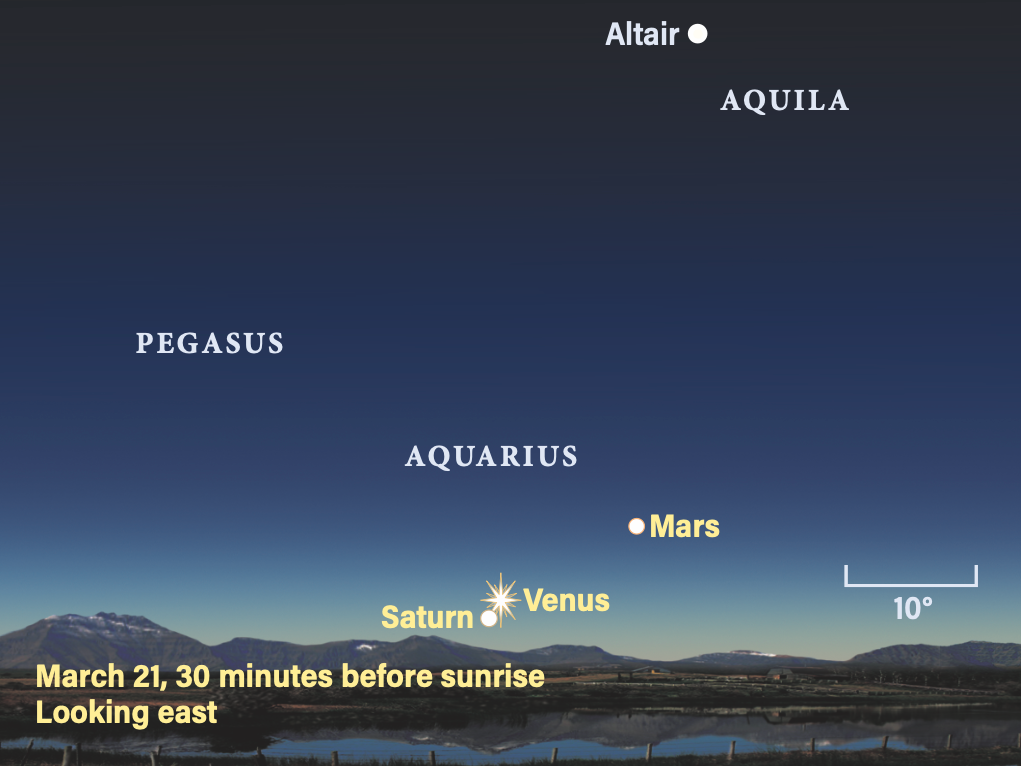
Friday, March 15
The waxing Moon sits in Taurus the Bull this evening, slowly sinking in the west after sunset. Luna hangs over the Pleiades (M45), a sparkling cluster of young stars that many observers can easily pick out with the naked eye. To the Moon’s lower left is magnitude 0.9 Aldebaran, a red giant star that marks Taurus’ eye.
Also in Taurus this month is asteroid 4 Vesta, heading slowly toward the feet of Gemini. Glowing around 8th magnitude, Vesta should be an easy catch with binoculars or a small scope, even under suburban skies. Find it tonight about 3.2° north-northeast of Zeta (ζ) Tauri. This 3rd-magnitude star marks the tip of the Bull’s southeastern horn. Slightly northwest of it is brighter, 2nd-magnitude Elnath (Beta [β] Tau, but also historically cataloged as Gamma [γ] Aurigae), which marks the tip of Taurus’ other horn.
Vesta is just under 3° northeast of M1 tonight, also known as the Crab Nebula. Observers with larger scopes and good skies can try spying this fuzzy, 8th-magnitude supernova remnant once twilight fades, though the nearby Moon may make the elusive target a little harder than usual to spot.
Sunrise: 7:11 A.M.
Sunset: 7:08 P.M.
Moonrise: 10:08 A.M.
Moonset: 12:48 A.M.
Moon Phase: Waxing crescent (35%)
*Times for sunrise, sunset, moonrise, and moonset are given in local time from 40° N 90° W. The Moon’s illumination is given at 12 P.M. local time from the same location.
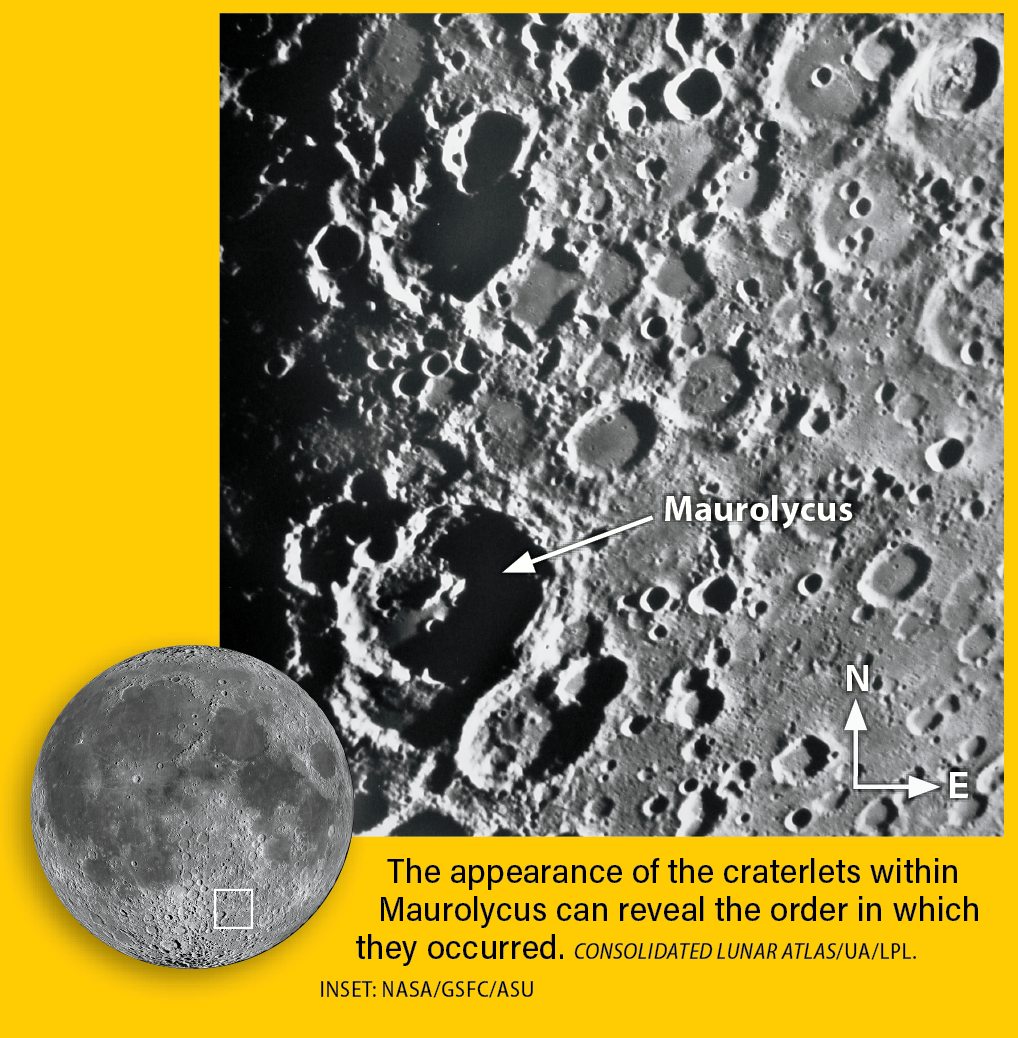
Saturday, March 16
With the Moon reaching First Quarter tonight (shortly after midnight EDT, late on the 16th for all other time zones), let’s turn our gaze toward our satellite — specifically, the rugged terrain in the lunar south.
Tonight, our telescopic target is the 70-mile-wide (113 kilometers) crater Maurolycus, which you can use the map above to locate. This complex crater hosts a cluster of central peaks — a common characteristic of impact craters — which form as the newly excavated crater slumps back on itself due to gravity, piling material up in the center even as the material beneath the crater floor is also rebounding from the impact, further pressing the peaks upward.
But that’s not the only sign of upheaval in the area. Maurolycus also features several craterlets along its floor, as well as a batch of craters carved into its northwestern rim. Take a look at the latter — can you tell the order in which they were made, based on the way they overlap each other and the edge of larger Maurolycus?
Sunrise: 7:09 A.M.
Sunset: 7:09 P.M.
Moonrise: 10:53 A.M.
Moonset: 1:59 A.M.
Moon Phase: Waxing crescent (45%)
Sunday, March 17
First Quarter Moon occurs at 12:11 A.M. EDT, late on the 16th for all time zones farther west.
Rising in the east after sunset is the constellation Leo the Lion, looking as though the great cat is heading upward in the sky. Look for the famous Sickle asterism, which frames the Lion’s head and looks to many observers like a backwards question mark. The Sickle starts at Leo’s heart, magnitude 1.4 Regulus, which connects to Eta (η) Leonis to form the straight handle of the tool. From there, the blade curves around in a clockwise fashion, to Gamma, Zeta, Mu (μ), and finally Epsilon (ϵ) Leo.
Keep watching as the hours pass and you’ll see Virgo start to climb above the eastern horizon as well, following Leo. This constellation’s Gamma star, also called Porrima, is a beautiful double star with an orbital period of 169 years. The stars last came closest in the early 2000s and are slowly growing farther apart, making them ever easier to split. They are now a bit more than 4″ apart and can be spotted as separate suns under magnifications of about 100x.
Neptune is in conjunction with the Sun at 7 A.M. EDT, hence why the distant ice giant is not visible this month.
Sunrise: 7:07 A.M.
Sunset: 7:10 P.M.
Moonrise: 11:47 A.M.
Moonset: 3:02 A.M.
Moon Phase: Waxing gibbous (56%)
Monday, March 18
Want to see a strange trick of the solar system’s geometry? Tonight, turn your telescope on the bright planet Jupiter as soon as you’re able after sunset. The giant planet hangs in the west, about 40° high 20 minutes after the Sun disappears.
Three of Jupiter’s Galilean moons — Europa, Io, and Ganymede — lie far west of the planet. But the fourth, Callisto, is trekking from west to east north of the gas giant, passing over its pole with several arcseconds of clearance!
What’s going on? The Galilean moons orbit Jupiter in the same plane, just as the planets orbit the Sun. That plane is roughly aligned with Jupiter’s equator. But, due to the changing angle at which we see Jupiter from Earth, sometimes that plane doesn’t align with the plane of the moons’ orbits! So, depending on the angle at which we’re viewing the Jupiter system from here on Earth, Callisto — the farthest out of the Galilean moons — can seem to skim or miss the planet’s poles altogether as it orbits.
Check out the moons to Jupiter’s west as well. Early in the night, Europa is farthest out, then Io just west of Ganymede, which is closest in. But around 10 P.M. CDT, as the planet is setting on the East Coast, Io passes Ganymede as the former moves eastward and the latter moves westward. After that, Io is closer to the planet than Ganymede.
Sunrise: 7:06 A.M.
Sunset: 7:11 P.M.
Moonrise: 12:45 P.M.
Moonset: 3:55 A.M.
Moon Phase: Waxing gibbous (65%)
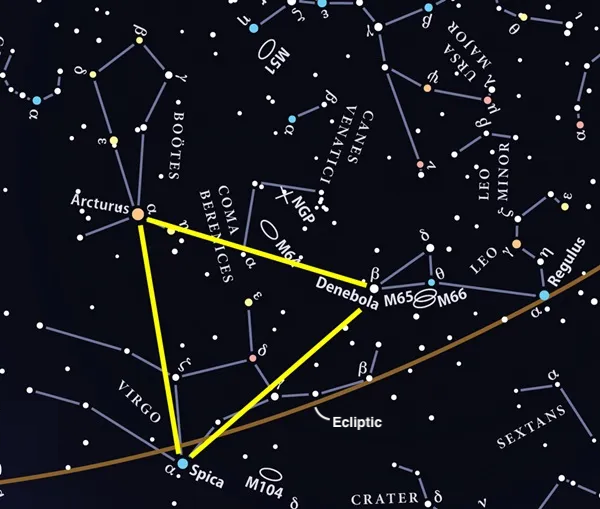
Tuesday, March 19
The vernal equinox occurs today at 11:06 P.M. EDT, bringing the official start of spring to the Northern Hemisphere. The vernal equinox occurs when the Sun’s northward path through the sky, the ecliptic, crosses the celestial equator, which is a projection of Earth’s equator outward into the celestial sphere of the sky.
What better way to celebrate spring than to look for the Spring Triangle in the sky? This asterism is anchored by three bright, well-known stars, rising in the east in the early-evening hours: Arcturus (Alpha [α] Boötis, magnitude 0), Spica (Alpha Virginis, magnitude 1), and Denebola (Beta Leonis, magnitude 2). By 10 P.M. local daylight time, the Spring Triangle is well above the eastern horizon.
Ready for more spring-themed targets in the sky? Look farther west along the ecliptic, to the upper right of Leo, and you’ll spot Cancer the Crab. At the center of this constellation lies M44, also known as the Beehive Cluster. For some, this is a fuzzy naked-eye object; for all, though, binoculars or a telescope will bring out a stunning set of young stars, at least 80 of which are brighter than 10th magnitude. The Beehive shines with a total magnitude of about 3.7 and spans nearly 100′ on the sky, slightly smaller than the Pleiades.
Sunrise: 7:04 A.M.
Sunset: 7:12 P.M.
Moonrise: 1:48 P.M.
Moonset: 4:39 A.M.
Moon Phase: Waxing gibbous (74%)
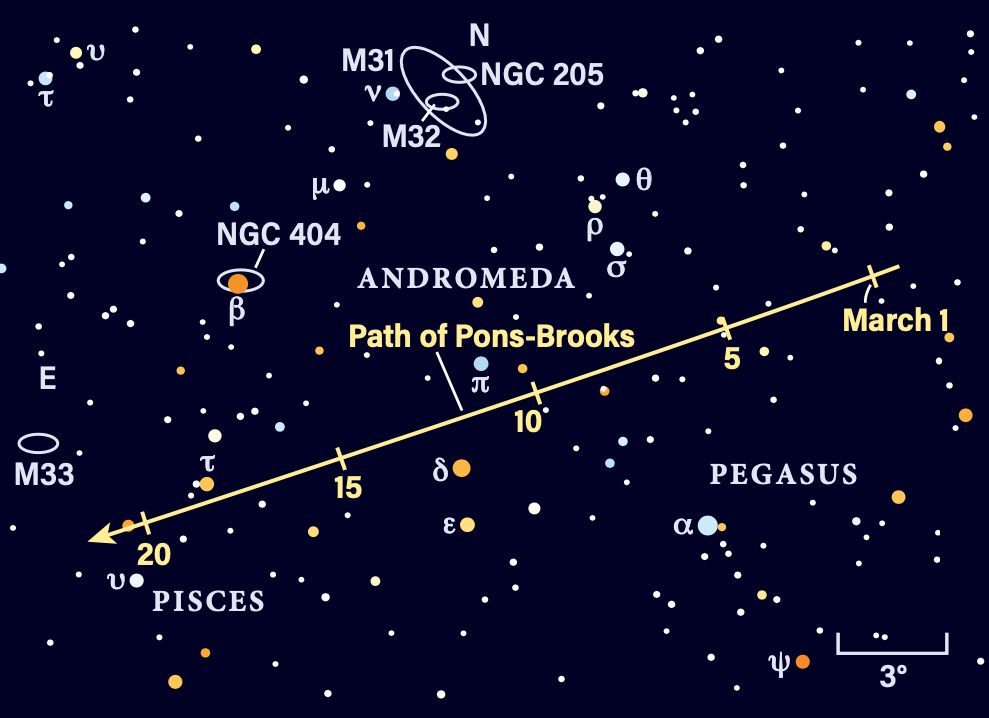
Wednesday, March 20
Comet 12P/Pons-Brooks is on the rise — but also falling fast! Its brightening glow, now roughly around magnitude 5, is offset by its sinking altitude in the sky after sunset. But it’s worth seeking out for those observers who are quick about it.
You’ll find Pons-Brooks about 25° high in the west some 30 minutes after sunset. It’s in Andromeda, having recently passed the constellation’s eponymous galaxy. Together with Mercury (magnitude –7 and 10° high in Pisces) and Jupiter (magnitude –2.1 and 35° high in Aries), Pons-Brooks forms a triangle or arrow pointing to the right (north), with the comet at the northward-facing point. As the sky darkens, you can use magnitude 2.1 Mirach (Beta Andromedae) as a signpost — Pons-Brooks lies about 7° south of this star.
The so-called “Devil Comet” (for its appearance during early outbursts) is fast approaching perihelion, when it passes closest to the Sun. As it does, it should continue to brighten, though astronomers aren’t sure how much. Many are hopeful it will reach easy naked-eye magnitude, earning it a spot as a great comet. We’ll have to wait and see, but for now, it’s easily viewed with binoculars or any small scope for as long as you can catch it before it sinks too close to the horizon within two to three hours after sunset. Note, too, that the waxing Moon is shedding plenty of light over the sky, somewhat affecting visibility even after twilight. Fortunately, the comet is bright enough now that it shouldn’t matter much.
Sunrise: 7:03 A.M.
Sunset: 7:13 P.M.
Moonrise: 2:52 P.M.
Moonset: 5:14 A.M.
Moon Phase: Waxing gibbous (82%)
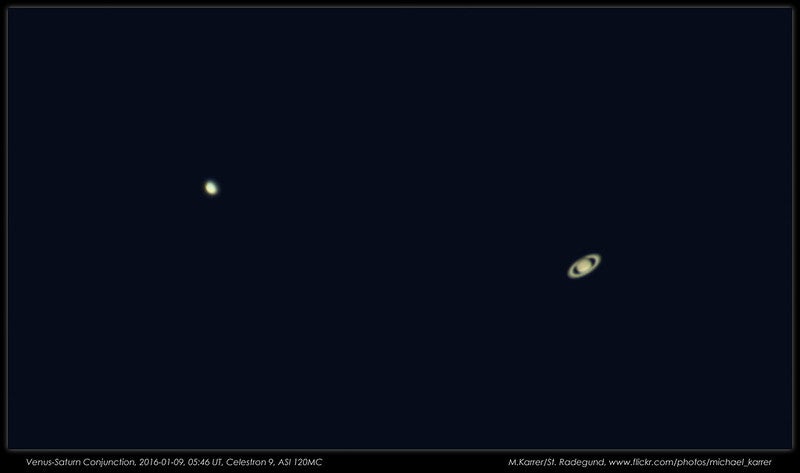
Thursday, March 21
It’s always a magnificent treat to see two planets at once in your eyepiece, and this morning offers that chance. Venus and Saturn stand just 0.6° apart in the early-morning sky today, readily visible together in binoculars or any telescope. Note, though, that this observation is a bit tricky, because the planets are also only 2.5° above the horizon a mere 20 minutes before sunrise.
Fortunately, Venus is bright and easy to find, a blazing magnitude –3.9 point of light that’s readily visible even in the growing twilight. Saturn is much dimmer, just magnitude 1 as it sits to Venus’ east (lower left) this morning.
Once you’ve got the pair of planets in your sights, take the chance to compare and contrast them. Venus appears 11″ across and nearly 94 percent lit. Saturn’s disk is some 16″ across and fully illuminated by the Sun. The giant planet’s stunning rings are about 35″ across and tilted by about 5°. And about 13° west of the pair is a third planet — magnitude 1.3 Mars. See if you can spot it, too, by sliding your gaze west along the ecliptic, to the upper right of the planetary pairing in the sky.
Take care when making this observation — of course it’s mesmerizing, but you’ll want to put away your optics at least several minutes before sunrise from your location, which may differ from the time given below.
Venus will pass 0.3° north of Saturn at 10 P.M. EDT. If you catch the pair again tomorrow morning, the brighter planet will appear northeast of Saturn, putting it on the other side (left) of the ringed planet. The planets will be about 0.7° apart then.
Sunrise: 7:01 A.M.
Sunset: 7:14 P.M.
Moonrise: 3:55 P.M.
Moonset: 5:43 A.M.
Moon Phase: Waxing gibbous (89%)
Friday, March 22
Mercury is fast approaching its greatest eastern elongation from the Sun, which it reaches in just two days.
Tonight, the tiny planet reaches 50 percent lit and spans 7″ on the sky. You can catch it easily after sunset, glowing at magnitude –0.5 and still 6° high in the west an hour after sunset. Although it can’t outshine Jupiter a little higher up in the sky, it’s still a bright, unmissable point of light slowly sinking toward the horizon in the evening sky.
If you’d like to net a bonus planet in the west, Uranus lies in Aries not far from Jupiter, just 5° northeast of the gas giant. You’ll need binoculars or a small scope to net the distant world, which glows at magnitude 5.8 and spans just over 3″ in apparent diameter. Look for a gray-hued, “flat” star just 2.2° due south of magnitude 4.3 Botein (Delta [δ] Arietis) in your optics.
Sunrise: 6:59 A.M.
Sunset: 7:15 P.M.
Moonrise: 4:56 P.M.
Moonset: 6:07 A.M.
Moon Phase: Waxing gibbous (94%)

Sky This Week is brought to you in part by Celestron.









